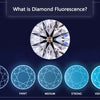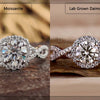
How do I know if my moissanite is real?
On the market, moissanite is frequently faked or zircon is used in its place. It turns white and black after being worn for a while. There are now vendors selling moissanite jewelry with certifications of authenticity, which will greatly encourage customers to make confident purchases. Yet, the retail price increases significantly with the appraisal, therefore it doesn't seem worthwhile to consider the value. Due to its brilliance and resemblance to a diamond in appearance, the lab-created gemstone moissanite frequently gets mistaken for a diamond. Here are some methods for checking the authenticity of your moissanite:
Eye-catching 2.51 CT Princess Cut Colorless Moissanite Solitaire Ring
- Verify the certification. Your moissanite diamond should have a certification from a Gemological laboratory if you bought it from a reputable dealer. That the stone is moissanite and not a diamond or other gemstone should be specified in this certification.
- Use a diamond tester to determine whether the stone is moissanite or not since moissanite has a different electrical conductivity than diamonds. This approach may not always be accurate, so take in mind that some diamond testers may not be able to tell moissanite from diamonds.
- Watch out for double refraction since moissanite can produce it because it has a higher refractive index than diamonds. While a diamond won't exhibit this appearance, a moissanite stone may have double lines or edges when viewed through.
- Look at the color: Under certain lighting situations, moissanite frequently has a yellow or green hue, but diamonds do not. Your stone might be a diamond or another kind of gemstone if it appears colorless in all lighting conditions.
You can take your moissanite diamond to a qualified jeweler or gemologist who can do more complex tests to confirm its authenticity if you're still not sure if it's real or not.
Is Moissanite Diamond a Fake Diamond?
Although Moissanite closely resembles diamond in appearance, it is not a "fake" diamond. Sometimes people who are not related by blood might resemble each other very closely—almost like twins. These pairings are known as Doppelgangers. Even if two people may come from very different families and even locations in the world, their physical features may be quite similar. Although their similarities are remarkable, you can discern differences in their features if you look closely; they are not an exact match.
Vintage 2 CT Portuguese Colorless Loose Moissanite for Engagement Ring
It would frequently be simple to confuse doppelgangers for one another if you hadn't seen them together. Those who don't know them very well could have problems identifying them, even when they ARE together. The link between Moissanite stone and diamond is extremely similar to that phenomenon. Although coming from various family pools and are composed of diverse materials, they remarkably resemble one another. Although moissanite jewelry has its unique identity, most people have problems identifying it apart from diamonds due to its similar appearance.
Moissanite History
The stone known as moissanite (silicon carbide) is real, despite having a diamond-like appearance. Moissanite has an intriguing history. Henri Moissan, a French chemist, was exploring the Arizona meteor impact site in 1893 when he discovered several little crystals that appeared to be diamonds. The crystals were collected, and he took them with him. He thought the crystals were diamonds for a long time, but 11 years later he realized they were something different, something brand-new. Afterward, the stone was given the name Moissanite in recognition of its discoverer.
The Moissanite Facts
Since then, moissanite stone has been discovered numerous times in modest amounts, although it is usually always near the locations of meteorite impacts. A very little amount has also been discovered on the rough diamonds' crust. Compared to diamond and possibly all other gems used in jewelry, natural moissanite is far rarer. Few people would ever be able to acquire natural Moissanite if that were our sole option due to the outrageous price that its scarcity would require. As a result of the meteorite being linked to having high-speed contact with the earth, natural Moissanite stone is not only incredibly difficult to locate but also practically impossible to obtain in gem quality.
The crystals of natural moissanite are frequently very tiny and broken. The majority of crystals are 1.5mm in size, or.015 carats or less. Just 4.1mm was the largest natural Moissanite crystal ever discovered (which translates to roughly .25 carats). The Moissanite used in modern jewelry is entirely synthetic because supply is so constrained.
3.00 MM to 11.0 MM Round Old European Cut Loose Moissanite
All of the characteristics of naturally occurring moissanite are replicated in lab-created moissanite, but labs can manufacture stones that are much larger and more suitable for jewelry.
The Mohs scale of hardness gives moissanite a 9.25 rating, making it a highly tough stone. The hardest known natural substance is a diamond, which has a hardness rating of 10. In contrast, rubies and sapphires rate a 9 on the Mohs scale, which means that while either of those stones could scratch a moissanite, they wouldn't be strong enough to do so. Although Moissanite appears quite similar to diamond from a distance, it is a magnificent stone all by itself. It's not just appealing or desirable because it looks like a diamond.
Can a jeweler identify moissanite?
Certainly, a skilled jeweler or gemologist ought to be able to recognize moissanite. Even though moissanite and diamond can appear to be quite similar, a skilled professional can recognize a few variances.
While identifying a stone, jewelers may use specialist equipment like a loupe or microscope to check the stone's clarity and inclusions. They might also employ a diamond tester, which can tell whether a stone is a moissanite or a diamond by measuring its electrical conductivity.
Moreover, a jeweler could be able to recognize moissanite based on its double refraction, which, when magnified, might result in double lines or edges within the stone. It's always a good idea to get your moissanite jewelry analyzed by a qualified jeweler or gemologist who can give you a conclusive response if you're dubious about its genuineness.
Can the average person tell moissanite?
The ordinary individual may find it challenging to distinguish between moissanite and diamond with their naked sight. A lab-created gemstone called moissanite is frequently used in jewelry as a substitute for diamonds because of its resemblance in appearance.
With a thorough inspection, certain variances can be seen. In general, moissanite jewelry sparkles more and can resemble a rainbow in certain circumstances because it has more fire and brilliance than a diamond. Under some lighting situations, it could also have a yellow or green hue, but a diamond won't.
Also, due to its twofold refraction, which is absent in diamonds, if you magnify a moissanite stone, you might be able to detect double lines or edges inside the stone. Although some people may be able to distinguish these changes, it can be challenging for the typical person to accurately identify a moissanite stone without the use of specialized tools or the knowledge of a qualified jeweler or gemologist.
Does a diamond tester pick up moissanite?
As moissanite possesses electrical conductivity that is comparable to diamonds', the majority of diamond testers can identify it. Diamond and moissanite both have the property of electrical conductivity, which is how diamond testers operate.
When it comes to testing the authenticity of gemstones, diamond testers have always been the favored tool. However, with the increasing popularity of moissanite as a diamond alternative, many often wonder if diamond testers can successfully detect the presence of moissanite.
To answer this question, it's important to understand the fundamental differences between diamonds and moissanite. While diamonds are a natural mineral, moissanite is a synthetic gemstone created in laboratories. Moissanite also boasts a higher refractive index compared to diamonds, which gives it more sparkle and a rainbow-like effect.
19.29 CT Emerald Cut Colorless Moissanite, Loose Moissanite for Custom Engagement Ring
When it comes to detecting the presence of moissanite using traditional diamond testers, the answer is no. Most diamond testers work based on thermal conductivity, which is a property that diamonds exhibit due to their dense molecular structure. Since moissanite has a different molecular structure, diamond testers are unable to detect its presence.
Nevertheless, specific devices have been developed to cater to the needs of detecting moissanite. These devices work based on electrical conductivity and can detect moissanite. However, these devices are not the standard in the market and are not commonly used for gemstone authentication.
Conclusion
A silicon carbide material like a diamond is called moissanite. A stone that resembles a diamond but isn't one is referred to as a diamond simulant. A typical alternative to diamonds is moissanite because it is exceedingly difficult to distinguish between the two. Moissanite gemstones are suitable for everyday wear because they are rated a 9.25 on the Mohs scale of hardness. The Mohs Scale of Hardness rates diamonds as the hardest known mineral at a 10.
Hope this guide is useful to you guys. For more details visit our website Diamondrensu.
Leave a comment
Please note, comments must be approved before they are published.













